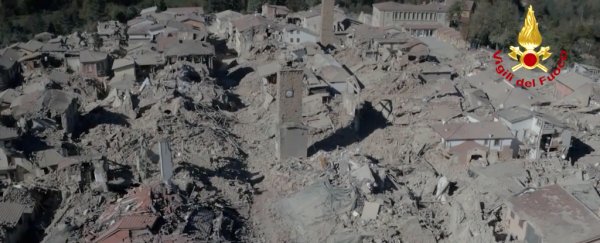A magnitude 6.6 earthquake levelled an historic town in central-northern Italy on Sunday, destroying two iconic churches and shattering part of a mountain.
It was the largest earthquake to hit Italy since 1980, and the third powerful quake to strike the region in the past two months. Thankfully, no deaths have been reported, but experts expect more shocks to follow over the next few days.
The drone footage below shows the destruction to the town of Armatrice, which was closest to the epicentre of the 6.2 magnitude earthquake back in August, and has now been almost entirely flattened following the latest quake:

The nearby Umbrian town of Norcia was closest to this latets epicenture, and two important churches have been destroyed by the shock: the 14th century Basilica of St Benedict, which was built on the traditional birthplace of St Benedict, founder of the Benedictine monastic order; and the 15th century Cathedra of St Mary Argentea.
You can see the cracked facades of both churches still standing in the footage above, but most of their structure has collapsed into rubble.
Local media is also reporting that the quake was so powerful, it shattered a nearby mountain, and could trigger landslides in the region.
#Terremotocentroitalia, fratture sui rilievi montuosi nei pressi dell’epicentro. In diretta con @Monicanpl #Canale50 https://t.co/JyQT9ybAWd pic.twitter.com/EaCwqEsvNa
— Sky tg24 (@SkyTG24) October 30, 2016
"Feeling the earth collapse beneath your feet is not a metaphorical expression but is what happened this morning, and half of Italy felt this," Italian Premier Matteo Renzi told the Associated Press (AP).
"Television images showed nuns rushing into the main piazza as the bell tower appeared on the verge of collapse," the AP reported. "Later, nuns and monks knelt in prayer in the main piazza."
Around 20 people reportedly sustained injuries, but they were mostly minor.
Norcia lies in the Apennine mountains, a region that sits on top of a series of fault lines, and has a long history of tectonic activity.
This latest series of earthquakes started with a magnitude 6.2 quake on August 24, which killed 300 people. A magnitude 6.1 quake followed on October 26.
The activity is a result of the African tectonic plate pushing into the Eurasian plate at a rate of around 2 centimetres every year.
And seismologists say they can't rule out more - and possibly stronger - quakes in the near future.
"It is normal for the Apennines," the president of Italy's National Institute for Geophysics and Vulcanology, Carlo Doglioni, told the AP. He added that a similar sequence of three events occurred within a period of months in the region in 1703.
Already over the weekend, more than 200 other seismic events were recorded by the institute, including 15 quakes between magnitude 4 and 5.
The United States Geological Survey (USGS) has suggested that the event loosened up the fault lines in the region, meaning they can now slip more easily than before.
"We can expect aftershocks to continue for weeks and possibly months," writes the USGS. "We cannot rule out the possibility of similar sized or larger events, though the probability of a larger event is low."
Right now, the tens of thousands of people who have been evacuated from the region remain homeless, and Italy faces the prospect of trying to replace centuries of cultural monuments.
Let's hope the region has seen the worst of the shocks for now.
Update 2 November 2016: We've updated the text to clarify that the drone footage shows the Italian town of Armatrice, not Norcia.
